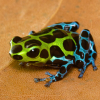Did they not work well? What's the history there?
- Formiculture.com
- Forums
- Gallery
- Members
- Member Map
- Chat

Did they not work well? What's the history there?
thanks for the answer ![]()

POPULAR
The wide accessibility of plaster and stone materials, in combination with the degree of skilled required to build a functional formicarium in general, has likely led many inept users to share their poor experiences and misinformed observations. As a result, users continue to perpetuate many misconceptions about these materials:
Contrary to popular opinion, the plaster material itself cannot mold, as it is a completely inorganic, mineral compound consisting mostly of hydrated calcium sulphate. Mold feeds and grows exclusively on organic material brought into the environment or otherwise produced by the ants (such as faeces, uneaten insects, plant matter, etc.), which is true regardless of whether the growth medium is a plaster formicarium or a plastic ziploc bag. A material that absorbs water, such as ytong, plasters and stones, grout, unglazed ceramics, or kiln-fired clay will have a slightly higher propensity to aid the growth of mold because these porous materials wick and hold moisture, which is also necessary for the mold to grow.
It is important to differentiate between plasters and stones. Plaster of paris cures to a soft, carvable state, becoming even softer when damp, making it only suitable for non-destructive species like Lasius. In contrast, gypsum stones and cements, which include trade name materials like "hydrostone," "labstone," and "hydrocal" are like plaster, but cure to a much harder state. Labstone is used by most myrmecology labs because of its ability to readily absorb and slowly release moisture, simulating a subterranean environment, but without soil, in addition to its toughness.
Plasters and stones can be used by amateurs and advanced craftsmen to produce an infinite range of finished products. Here is one creation, in particular, that I really like:
Edited by drtrmiller, August 3 2017 - 1:16 AM.
Regarding Labstone, are you referring to this?:
I think the increasing availability of acrylic and 3D printed nests is playing a role.
The wide accessibility of plaster and stone materials, in combination with the degree of skilled required to build a functional formicarium in general, has likely led many inept users to share their poor experiences and misinformed observations. As a result, users continue to perpetuate many misconceptions about these materials:
Contrary to popular opinion, the plaster material itself cannot mold, as it is a completely inorganic, mineral compound consisting mostly of hydrated calcium sulphate. Mold feeds and grows exclusively on organic material brought into the environment or otherwise produced by the ants (such as faeces, uneaten insects, plant matter, etc.), which is true regardless of whether the growth medium is a plaster formicarium or a plastic ziploc bag. A material that absorbs water, such as ytong, plasters and stones, grout, unglazed ceramics, or kiln-fired clay will have a slightly higher propensity to aid the growth of mold because these porous materials wick and hold moisture, which is also necessary for the mold to grow.
It is important to differentiate between plasters and stones. Plaster of paris cures to a soft, carvable state, becoming even softer when damp, making it only suitable for non-destructive species like Lasius. In contrast, gypsum stones and cements, which include trade name materials like "hydrostone," "labstone," and "hydrocal" are like plaster, but cure to a much harder state. Labstone is used by most myrmecology labs because of its ability to readily absorb and slowly release moisture, simulating a subterranean environment, but without soil, in addition to its toughness.
Plasters and stones can be used by amateurs and advanced craftsmen to produce an infinite range of finished products. Here is one creation, in particular, that I really like:
Fantastic response, thank you!
I was asking because I found this youtube video a couple days ago actually, it seems the colony is doing well
Regarding Labstone, are you referring to this?:
I'm not too knowledgeable on the different grades or types, and I'm also not sure what that listing means by "base stone."
I recommend the white variation manufactured by The Plaster Guys.
Regarding Labstone, are you referring to this?:
I'm not too knowledgeable on the different grades or types, and I'm also not sure what that listing means by "base stone."
I recommend the white variation manufactured by The Plaster Guys.
Can it be colored (I usually prefer dull brown or grey)?
According to a site that covers 'dental gypsum types':
ISO 6873 Dental Gypsum Specification:
| Type | Setting Expansion | Compressive Strength |
|---|---|---|
| 1 / I | 0 - 0.15% | 580 - 1,160 psi |
| 2 / II | 0 - 0.30% | 1,300 psi (minimum) |
| 3 / III | 0 - 0.20% | 2,900 psi (minimum) |
| 4 / IV | 0 - 0.15% | 5,100 psi (minimum) |
| 5 / V | 0.16 - 0.30% | 5,100 psi (minimum) |

Regarding Labstone, are you referring to this?:
I'm not too knowledgeable on the different grades or types, and I'm also not sure what that listing means by "base stone."
I recommend the white variation manufactured by The Plaster Guys.
Regarding Labstone, are you referring to this?:
I'm not too knowledgeable on the different grades or types, and I'm also not sure what that listing means by "base stone."
I recommend the white variation manufactured by The Plaster Guys.
Can it be colored (I usually prefer dull brown or grey)?
According to a site that covers 'dental gypsum types':
ISO 6873 Dental Gypsum Specification:
Type Setting Expansion Compressive Strength
1 / I 0 - 0.15% 580 - 1,160 psi
2 / II 0 - 0.30% 1,300 psi (minimum)
3 / III 0 - 0.20% 2,900 psi (minimum)
4 / IV 0 - 0.15% 5,100 psi (minimum)
5 / V 0.16 - 0.30% 5,100 psi (minimum)
Types I and II are plasters, and for general application. Type III is 'model stone' or 'specialty stone', and is used for opposing models and bases (thus 'base stone'). Type IV is 'die stone', and is strong with a low expansion. Type V is high expansion 'die stone'.
It appears to be a typing system meant for dentists/orthodontists.
Plasterguys appear to sell Lab Plaster, Lab Stone, Orthodontic Plaster, Type IV plaster, AlumOxide, Dental Pumice, Snap-Stone, and Flow Stone. I did shoot them an e-mail asking them for specifics about the Lab Stone, however I then saw on their main page that it is listed as:
Lab Stone: Type 3 plaster...
So, Plaster Guys 'Lab Stone' is Type III Dental Plaster, so it should be the same as what is on Amazon.
I guess the only question now is, is it mold resistant?
Edited by TKD102, August 12 2017 - 6:39 PM.
Currently Keeping:
Tetramorium Immigrans
I'm not sure how to answer that. As he said, plaster is mold resistant as nothing in it is food for mold. It's porous and absorbs things, which likely contributes. I'm not aware of any surface, even glass, that is mold-proof. If it's porous, mold is more likely, but if it's not porous, it isn't water permeable.
Thanks for that, and I know this is kind of late but, would lab stone be able to stand up to ant species that are good are chewing through other types of plaster? It's compressive strength seems to be better, but I don't know about the material holding together when ants are chewing on it.
(I bought a bag of lab stone and I'm going to experiment with a design for a formicarium using it)
Edited by TKD102, July 17 2018 - 3:24 AM.
Currently Keeping:
Tetramorium Immigrans
Good information! Thanks @drtrmiller. I guess need to update the wiki: https://www.antkeepi...lding_Materials
Makes sense though in what you said.
BTW this is from
Posted August 13 2017 - 4:37 PMEdited by StopSpazzing, July 17 2018 - 7:57 AM.
I'm not sure how to answer that. As he said, plaster is mold resistant as nothing in it is food for mold. It's porous and absorbs things, which likely contributes. I'm not aware of any surface, even glass, that is mold-proof. If it's porous, mold is more likely, but if it's not porous, it isn't water permeable.
Thanks for that, and I know this is kind of late but, would lab stone be able to stand up to ant species that are good are chewing through other types of plaster? It's compressive strength seems to be better, but I don't know about the material holding together when ants are chewing on it.
(I bought a bag of lab stone and I'm going to experiment with a design for a formicarium using it)
Please let us know what you find!
Aphaenogaster cf. rudis
Tetramorium immigrans
Tapinoma sessile
Formica subsericea
Pheidole sp.
Camponotus nearcticus
0 members, 0 guests, 0 anonymous users